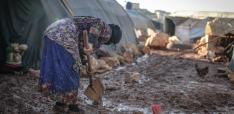What Restrains Extreme Violence – Culture or the Law?

Oxfam's Ed Cairns on how advocates of international humanitarian law have started getting excited about culture and norms.
Do we need to get used to war? That’s the frightening question from the 2018 Armed Conflict Survey, from the International Institute for Strategic Studies (IISS), launched with the blunt message that ‘peace processes are stalling… the number of armed groups is rising,’ and we’re facing ‘more drawn-out conflicts’ difficult to resolve.
Among other reasons, the IISS blames foreign intervention. In 2017, seventeen conflicts were subject to external meddling of one sort or another, considerably more than the eleven in 1997. With Russia bombing Deraa, and Saudi Arabia bombing Hudaydah, that trend doesn’t look like ending any time soon.
In a separate report this June, the International Committee of the Red Cross (ICRC) highlighted another reason. ‘Humanitarians, ‘ it said, ‘witnessed more armed groups emerge in the last seven years – than in the previous seven decades.’
 But the vital thing about this ICRC study, The Roots of Restraint in War, is not that it adds to the literature on the proliferation of armed groups, and fragmentation of conflicts. It’s that it looks at how to limit the hideous human cost of conflicts – and perhaps more than the ICRC has ever before acknowledged, suggests that international humanitarian law (IHL) is not enough.
But the vital thing about this ICRC study, The Roots of Restraint in War, is not that it adds to the literature on the proliferation of armed groups, and fragmentation of conflicts. It’s that it looks at how to limit the hideous human cost of conflicts – and perhaps more than the ICRC has ever before acknowledged, suggests that international humanitarian law (IHL) is not enough.
Based on research in South Sudan, Mali, Colombia, the Philippines, and with Australia’s armed forces, it asks what restrains fighters from committing atrocities – and finds that things are more complex than they seem.
In Mali, two groups, both linked to Al Qaeda, did not behave in the same way – one was significantly worse in using suicide bombers and sexual slavery. From this and other cases, the ICRC drew a wider lesson, that the decentralised armed groups that proliferate in modern conflicts may be open to influence from diverse external sources, such as community leaders – and that at least some of those external sources are restraining their violence.
This is important, but the real ‘take-away’ from this research, ICRC Vice-President Gilles Carbonnier told an audience at RUSI in London, is that the ICRC should broaden the way it tries to influence armed forces and armed groups’ behaviour. The ICRC is after all the guardian of international humanitarian law. Its usual message is ‘the power of law’, as its President Peter Maurer told the UN Human Rights Council last year. But it seems increasingly conscious that law, by itself, is not enough.
Years ago, in 2004, the ICRC’s earlier research, The Roots of Behaviour in War, showed that it’s not enough to spread knowledge of international humanitarian law. Since then, the ICRC’s increasingly focussed on the ‘formal socialisation’ of IHL through the doctrines and training of armed forces.
But what their new research suggests is that it’s far more informal things, like the peer pressure of other fighters or the sense of ‘who we are’, that is at least as important to influence whether combatants restrain violence or not. When a fighter is about to slaughter a child or civilian, the momentary thought that may stop him is not some basic knowledge of IHL; it’s that this is not what an ‘honourable warrior’ (in Islamic culture) or ‘a US Marine’ should do. It’s identity and cultural values – consistent with, but more emotionally powerful than, IHL.
So where does this leave the ICRC and its mission to uphold IHL? Carbonnier said that it must focus more on the
‘informal socialisation’ of IHL, meaning highlighting the values and identities of communities, armed groups and societies that are consistent with IHL. The Roots of Restraint study’s most important finding is this:
An exclusive focus on the law is not as effective at influencing behaviour as a combination of the law and the values underpinning it. Linking the law to local norms and values gives it greater traction. The role of law is vital in setting standards, but encouraging individuals to internalize the values it represents through socialization is a more durable way of promoting restraint.
Should other organisations draw similar conclusions? Oxfam, for instance, isn’t an agency rooted in IHL in the way that ICRC is, but it tends to highlight IHL in much of its advocacy on humanitarian crises. Other organisations, such as Geneva Call, seek to build non-state armed groups’ knowledge of IHL rules, and their capacities to implement them. Only this month, the UK parliamentary group on Yemen heard from a Yemeni women’s rights activist about women’s community-based organizations training Yemeni fighters in the rules of war, which had indeed had an impact on their behaviour.
But should Oxfam – like the ICRC – think beyond law? It condemns the never-ending killing, and calls on all parties to protect civilians through respecting IHL. Its latest briefing on Yemen calls for all parties to “respect international law and uphold the rules of war” – quite rightly of course. But Oxfam doesn’t talk so much about religious or cultural values that might restrain violence as well. That’s not necessarily easy to do. It requires knowledge of the local values and identities that warring parties and their combatants may hold. But it’s something that we all – not just the ICRC – may need to develop far more in the future.
This post first appeared on:
Image credit: Johnny Silvercloud via Flickr (CC BY-SA 2.0)

